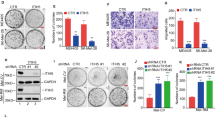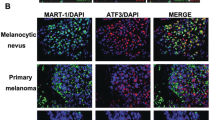Abstract
Activating mutations of the genes for NRAS and BRAF, components of the p44/42 mitogen-activated protein kinase (MAPK) pathway, are common findings in melanoma. Recent evidence in several nonmelanoma cell systems supports the regulation of the inducible nitric oxide synthase (iNOS) gene by this pathway. On the basis of our data showing that melanoma iNOS expression predicts shortened patient survival, we formulated the hypothesis that activating mutations of NRAS or BRAF, which lead to constitutive activation of the p44/42 MAPK pathway, drive iNOS expression in human melanoma. In the present study, we have shown that inhibition of melanoma iNOS activity by S-methylisothiourea leads to decreased cell proliferation, confirming the importance of iNOS activity for melanoma cell growth. Regulation of melanoma iNOS expression by the p44/42 MAPK pathway was demonstrated by inhibition of the pathway by U0126, and by BRAF RNA interference. To explore this regulatory pathway in human tissue, 20 melanoma tumors were examined for NRAS and BRAF mutations, immunohistochemical evidence of ERK phosphorylation, and iNOS expression. A significant association was found among these three features. We conclude that in human melanoma, activating mutations of NRAS and BRAF drive constitutive iNOS expression and, implicitly, nitric oxide production, contributing to the poor survival of these patients.
This is a preview of subscription content, access via your institution
Access options
Subscribe to this journal
Receive 50 print issues and online access
$259.00 per year
only $5.18 per issue
Buy this article
- Purchase on Springer Link
- Instant access to full article PDF
Prices may be subject to local taxes which are calculated during checkout





Similar content being viewed by others
References
Bhat NR, Fan F . (2002). Brain Res 948: 93–101.
Brose MS, Volpe P, Feldman M, Kumar M, Rishi I, Gerrero R et al. (2002). Cancer Res 62: 6997–7000.
Colasanti M, Suzuki H . (2000). Trends Pharmacol Sci 21: 249–252.
Davies H, Bignell GR, Cox C, Stephens P, Edkins S, Clegg S et al. (2002). Nature 417: 949–954.
Demunter A, Stas M, Degreef H, De Wolf-Peters C, van den Oor JJ . (2001). J Invest Dermatol 117: 1483–1489.
Ekmekcioglu S, Ellerhorst J, Smid CM, Prieto VG, Munsell M, Buzaid AC et al. (2000). Clin Cancer Res 6: 4768–4775.
Ekmekcioglu S, Ellerhorst JA, Mumm JB, Zheng M, Broemeling L, Prieto VG et al. (2003). Mol Cancer Ther 2: 9–17.
Gay RD, Dawson SJ, Murphy WJ, Russell SW, Latchman DS . (1998). Biochim Biophys Acta 1443: 315–322.
Goodall J, Wellbrock C, Dexter TJ, Roberts K, Marais R, Gooding CR . (2004). Mol Cell Biol 24: 2923–2931.
Gorden A, Osman I, Gai W, He D, Huang W, Davidson A et al. (2003). Cancer Res 63: 3955–3957.
Guan KL, Figueroa C, Brtva TR, Zhu T, Taylor J, Barber TD et al. (2000). J Biol Chem 275: 27354–27359.
Jaramillo M, Gowda DC, Radzioch D, Olivier M . (2003). J Immunol 171: 4243–4253.
Jenkins DC, Charles IG, Thomsen LL, Moss DW, Holmes LS, Baylis SA et al. (1995). Proc Natl Acad Sci USA 92: 4392–4396.
Jiang B, Xu S, Hou X, Pimentel DR, Brecher P, Cohen RA . (2004). J Biol Chem 279: 1323–1329.
Kleinert H, Schwarz PM, Forstermann U . (2003). Biol Chem 384: 1343–1364.
Kristof AS, Marks-Konczalik J, Moss J . (2001). J Biol Chem 276: 8445–8452.
Liu X, Jana M, Dasgupta S, Koka S, He J, Wood C et al. (2002). J Biol Chem 277: 39312–39319.
Mason CS, Springer CJ, Cooper RG, Superti-Furga G, Marshall CJ, Marais R . (1999). EMBO J 18: 2137–2148.
Massi D, Franchi A, Sardi I, Magnelli L, Paglierani M, Borgognoni L et al. (2001). J Pathol 194: 194–200.
Mercer KE, Pritchard CA . (2003). Biochim Biophys Acta 1653: 25–40.
Omholt K, Karsberg S, Platz A, Kanter L, Ringborg U, Hansson J . (2002). Clin Cancer Res 8: 3468–3474.
Park SK, Lin HL, Murphy S . (1997). Biochem J 322: 609–613.
Perrotta C, Falcone S, Capobionca A, Camporeale A, Sciorati C, De Palma C et al. (2004). Cancer Res 64: 3767–3771.
Salvucci O, Carsana M, Bersani I, Tragni G, Anichini A . (2001). Cancer Res 61: 318–326.
Smalley KSM . (2003). Int J Cancer 104: 527–532.
Szabo C, Southan GJ, Thiemermann C . (1994). Proc Natl Acad Sci USA 91: 12472–12476.
Tang CH, Grimm EA . (2004). J Biol Chem 279: 288–298.
Wink DA, Mitchell JB . (1998). Free Radic Biol Med 25: 434–456.
Wink DA, Mitchell JB . (2003). Free Radic Biol Med 34: 951–954.
Yazdi AS . (2003). J Invest Dermatol 121: 1160–1162.
Zheng M, Ekmekcioglu S, Walch ET, Tang CH, Grimm EA . (2004). Melanoma Res 14: 165–171.
Acknowledgements
We thank Erika Thompson, Viju Varghese, Rashmi Pershad, and the staff of the MDACC DNA Analysis Core Facility for expert DNA sequencing; Drs A Hafeez Diwan and Victor Prieto for assistance in interpretation of immunohistochemistry data; and Lihong Long, Anita Myer, Sandra Kinney, Sandra Yekell, and Sandra Ortega-Mendez for technical advice and contributions.
This work was supported by NIH R01 CA90282 (EAG, SE); NIH P50 CA093459 (EAG, SE, JAE); and NIH CA16672 (DNA analysis facility). Its contents are solely the responsibility of the authors and do not necessarily represent the official views of the National Institutes of Health.
Author information
Authors and Affiliations
Corresponding author
Additional information
Supplementary Information accompanies the paper on the Oncogene website (http://www.nature.com/onc)
Supplementary information
Rights and permissions
About this article
Cite this article
Ellerhorst, J., Ekmekcioglu, S., Johnson, M. et al. Regulation of iNOS by the p44/42 mitogen-activated protein kinase pathway in human melanoma. Oncogene 25, 3956–3962 (2006). https://doi.org/10.1038/sj.onc.1209419
Received:
Revised:
Accepted:
Published:
Issue Date:
DOI: https://doi.org/10.1038/sj.onc.1209419
Keywords
This article is cited by
-
Absence of system xc − on immune cells invading the central nervous system alleviates experimental autoimmune encephalitis
Journal of Neuroinflammation (2017)
-
NF-κB Mediates Mitogen-Activated Protein Kinase Pathway-Dependent iNOS Expression in Human Melanoma
Journal of Investigative Dermatology (2009)
-
Prognostic significance of tumor iNOS and COX-2 in stage III malignant cutaneous melanoma
Cancer Immunology, Immunotherapy (2009)
-
Phospho-ERK Staining Is a Poor Indicator of the Mutational Status of BRAF and NRAS in Human Melanoma
Journal of Investigative Dermatology (2008)
-
Melanoma biology and new targeted therapy
Nature (2007)



